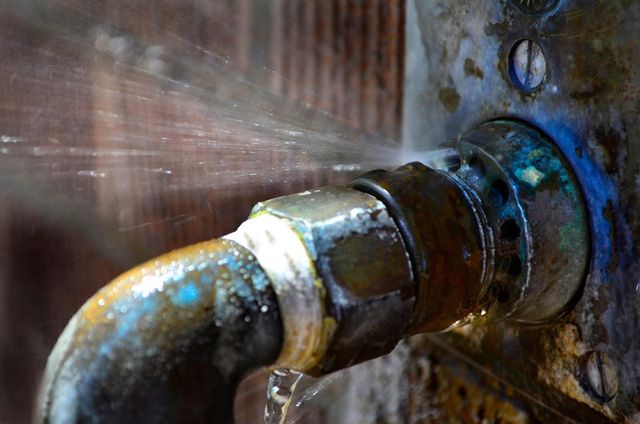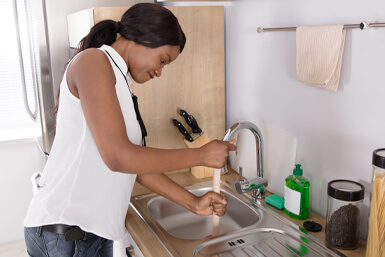Just about everyone maintains their personal thinking on the subject of Why Do My Plumbing Pipes Make A Knocking Noise.

To detect noisy plumbing, it is necessary to identify very first whether the undesirable audios occur on the system's inlet side-in other words, when water is transformed on-or on the drain side. Noises on the inlet side have varied causes: excessive water pressure, worn valve and faucet parts, improperly connected pumps or various other devices, inaccurately positioned pipeline fasteners, and plumbing runs including too many limited bends or other constraints. Noises on the drain side normally come from bad location or, as with some inlet side sound, a design including limited bends.
Hissing
Hissing noise that occurs when a tap is opened slightly usually signals extreme water pressure. Consult your regional water company if you presume this problem; it will certainly be able to tell you the water pressure in your location as well as can set up a pressurereducing shutoff on the inbound water system pipeline if required.
Thudding
Thudding sound, frequently accompanied by trembling pipelines, when a faucet or appliance valve is switched off is a problem called water hammer. The noise and also resonance are caused by the reverberating wave of pressure in the water, which instantly has no area to go. Sometimes opening a valve that discharges water quickly into a section of piping including a limitation, arm joint, or tee installation can generate the very same problem.
Water hammer can typically be treated by mounting installations called air chambers or shock absorbers in the plumbing to which the issue valves or taps are linked. These gadgets enable the shock wave created by the halted circulation of water to dissipate in the air they contain, which (unlike water) is compressible.
Older plumbing systems might have short vertical sections of capped pipeline behind wall surfaces on tap runs for the exact same purpose; these can eventually full of water, minimizing or destroying their effectiveness. The treatment is to drain the water supply completely by shutting down the main water valve as well as opening up all taps. Then open the major supply valve as well as close the taps one at a time, starting with the faucet nearest the valve and ending with the one farthest away.
Chattering or Shrieking
Extreme chattering or shrieking that takes place when a shutoff or tap is activated, and that generally goes away when the installation is opened completely, signals loose or faulty inner parts. The option is to replace the valve or faucet with a brand-new one.
Pumps and also home appliances such as cleaning equipments and dish washers can move motor noise to pipes if they are incorrectly attached. Connect such items to plumbing with plastic or rubber hoses-never rigid pipe-to isolate them.
Various Other Inlet Side Noises
Squeaking, squealing, damaging, breaking, and also touching normally are brought on by the growth or tightening of pipes, generally copper ones providing warm water. The audios happen as the pipelines slide versus loosened bolts or strike close-by house framework. You can often determine the location of the issue if the pipes are revealed; just adhere to the sound when the pipelines are making noise. More than likely you will discover a loosened pipeline wall mount or a location where pipelines exist so near flooring joists or other mounting items that they clatter versus them. Affixing foam pipeline insulation around the pipelines at the point of call need to remedy the problem. Be sure straps as well as wall mounts are safe and secure and also provide appropriate assistance. Where feasible, pipeline fasteners should be attached to enormous architectural aspects such as foundation walls rather than to mounting; doing so reduces the transmission of vibrations from plumbing to surfaces that can magnify as well as transfer them. If attaching fasteners to framing is inescapable, cover pipes with insulation or other durable material where they get in touch with bolts, as well as sandwich completions of new bolts in between rubber washing machines when mounting them.
Dealing with plumbing runs that struggle with flow-restricting limited or various bends is a last option that should be embarked on just after consulting a skilled plumbing service provider. Regrettably, this scenario is relatively typical in older homes that may not have been constructed with interior plumbing or that have actually seen numerous remodels, particularly by beginners.
Drain Sound
On the drain side of plumbing, the principal objectives are to remove surfaces that can be struck by falling or hurrying water and also to shield pipelines to have inescapable sounds.
In new building, tubs, shower stalls, toilets, and also wallmounted sinks as well as containers must be set on or against resilient underlayments to reduce the transmission of sound via them. Water-saving commodes and also taps are much less noisy than conventional models; mount them rather than older types even if codes in your area still allow utilizing older components.
Drainpipes that do not run up and down to the cellar or that branch right into straight pipeline runs sustained at flooring joists or various other framing present specifically problematic noise problems. Such pipes are big sufficient to radiate considerable vibration; they additionally bring significant quantities of water, which makes the circumstance worse. In brand-new construction, define cast-iron soil pipes (the large pipes that drain toilets) if you can afford them. Their massiveness consists of a lot of the sound made by water going through them. Also, avoid routing drainpipes in walls shared with bedrooms and rooms where individuals collect. Wall surfaces consisting of drainpipes must be soundproofed as was explained earlier, using dual panels of sound-insulating fiber board and also wallboard. Pipelines themselves can be wrapped with special fiberglass insulation produced the purpose; such pipes have a resistant vinyl skin (often including lead). Outcomes are not always satisfactory.
3 Most Common Reasons for Noisy Water Pipes
Water hammer
When water is running and is then suddenly turned off, the rushing liquid has no place to go and slams against the shut-off valve. The loud, thudding sound that follows is known as a water hammer. Besides being alarming, water hammer can potentially damage joints and connections in the water pipe itself. There are two primary methods of addressing this issue.
- Check your air chamber. An air chamber is essentially a vertical pipe located near your faucet, often in the wall cavity that holds the plumbing connected to your sink or tub. The chamber is filled with air that compresses and absorbs the shock of the fast moving water when it suddenly stops. Unfortunately, over time air chambers tend to fill with water and lose their effectiveness. To replenish the air chambers in your house you can do the following.
- Turn off the water supply to your house at the main supply (or street level).
- Open your faucets to drain all of the water from your plumbing system.
- Turn the water back on. The incoming water will flush the air out of the pipes but not out of the vertical air chamber, where the air supply has been restored.
Copper pipes
Copper pipes tend to expand as hot water passes through and transfers some of its heat to them. (Copper is both malleable and ductile.) In tight quarters, copper hot-water lines can expand and then noisily rub against your home's hidden structural features — studs, joists, support brackets, etc. — as it contracts.
One possible solution to this problem is to slightly lower the temperature setting on your hot water heater. In all but the most extreme cases, expanding and contracting copper pipes will not spring a leak. Unless you’re remodeling, there's no reason to remove sheetrock and insert foam padding around your copper pipes.
Water pressure that’s too high
If your water pressure is too high, it can also cause noisy water pipes. Worse, high water pressure can damage water-supplied appliances, such as your washing machine and dishwasher.
Most modern homes are equipped with a pressure regulator that's mounted where the water supply enters the house. If your home lacks a regulator, consider having one professionally installed. Finally, remember that most plumbers recommend that water is delivered throughout your home at no lower than 40 and no greater than 80 psi (pounds per square inch).
Whatever the state of your plumbing, one thing is certain — you’re eventually going to encounter repair and replacement issues around your home that require professional help. That’s where American Home Shield can come to your aid.
https://www.ahs.com/home-matters/repair-maintenance/causes-of-noisy-water-pipes/

I found that review about How To Fix Noisy Pipes when surfing the web. Be sure to take the time to distribute this page if you enjoyed reading it. Thank you for your time. Visit again soon.
Hot water issues?
Comments on “Guide To Diagnosing and Dealing with Noisy Plumbing”